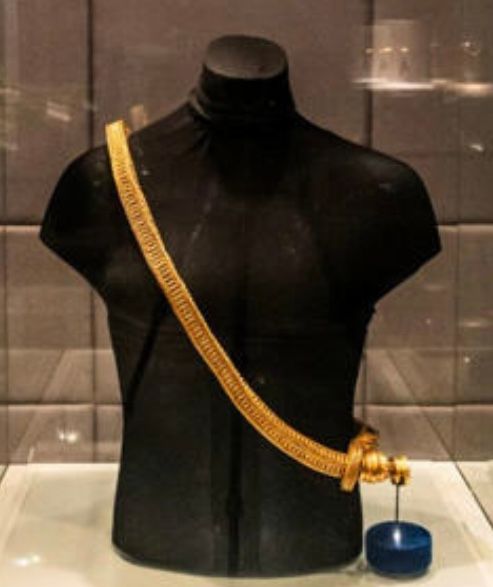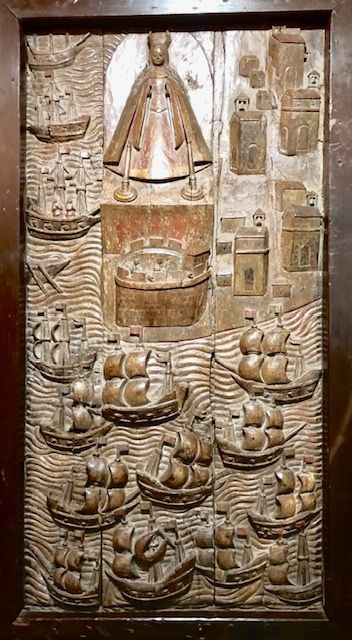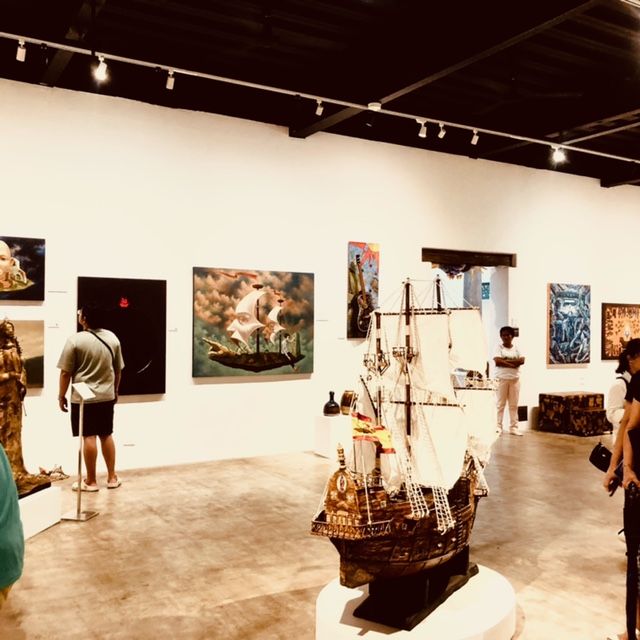WALA LANG
There are two ongoing must-see exhibits, one in Makati and the other in Antipolo. The former is at the Ayala Museum, of pre-Hispanic gold jewelry and the latter, at the Pinto Art Museum, of objects related to the Manila-Acapulco Galleon Trade and contemporary art works it has inspired.
Reuniting the Surigao treasure
Clandestine treasure hunters have been finding gold in pre-Hispanic graves of Butuan, Samar, Cagayan, and elsewhere. The largest and most spectacular discovery is the so-called “Surigao Treasure” discovered in 1981 in Barrio Magroyong of San Miguel, Surigao del Sur. The find is estimated to be more than a thousand years old.
Objects unearthed immediately found owners: finders were keepers. What were not melted down made their way to collectors, the most important of whom were Ar. & Mrs. Leandro V. Locsin and the Central Bank of the Philippines, now Bangko Sentral ng Pilipinas (BSP). The Locsin collection has long been on exhibit at the Ayala Museum and has been joined by a BSP loan of 38 important objects. The pieces will be together until 2027.

reunited with its finial (Ayala Museum)
What’s in the Surigao Treasure are not grave goods and, without solid archaeological evidence, one can only speculate if they are pirate booty, belongings of a fleeing elite group, intended gifts of a sultan to a lady love, whatever. New York’s Asia Society finessed the issue by calling its 2015 exhibit of Treasure items, the ambiguous, “Philippine Gold: Treasures of Forgotten Kingdoms.”
Heavy equipment operator Edilberto “Berto” Morales was busy on an irrigation ditch when he noticed bits of metal. He stopped and realized he had literally struck gold. He hurriedly gathered as much as he could and rushed off. Curious neighbors gathered and a free-for-all ensued. The military arrived and joined in the action. The National Museum was evidently the last to know.
Men, women, and children fought over the finds and often settled disputes by chopping objects up. Thus it was that gold belts were cut in two or three. Reportedly, a cape of gold links was cut into small pieces, distributed among claimants who promptly sold them by weight. Much might have ended up in melting pots, but some made their way to pawn shops, to dealers, and eventually to knowledgeable private collectors.
Jeweler Ramon Villegas and furniture expert Osmundo Esguerra, both scholarly antique dealers, gathered, reassembled, and repaired numerous objects and offered them in several batches to the Central Bank of the Philippines that I then headed as governor.
The Central Bank Money Museum already had a handful of pre-Hispanic gold objects, mainly barter rings. Following the example of Colombia’s Central Bank (Banco de la República), which has unparalleled holdings of pre-Columbian objects in the Museo del Oro, I recommended to the Monetary Board that the Money Museum be expanded to include pre-Hispanic gold. With its high purchasing power, the bank usually had first choice of whatever came to the Manila market and some exceptional objects, notably gold belts, soon joined the collection.

The centerpiece of the Locsin gold collection is a four-kilo gold sash (described as a Hindu upavita or “sacred thread”). I was shown the object, priced at four million pesos. It was an incredibly high price for 1982 and I decided that while it could be the Money Museum’s centerpiece, I could also be the centerpiece of newspaper headlines and public denunciations. I therefore turned it down and the object was immediately offered to the Locsins, who were able to bargain it down to two million pesos, there being no other buyer in sight.
The show unites not only the two collections’ highlights but also dismembered parts of two objects. The end piece of the unique sash had been removed from the body and was acquired by the Central Bank as an independent object. The meter-plus sash therefore ended up with the Locsins and the four-inch end piece, with the Central Bank. But a red stone (a ruby?), which was originally at the tip of the end piece, had disappeared. The two pieces without the red stone have temporarily come together at Ayala Museum.
Similarly separated were a small balance scale and the gold pans that were attached to it.
Ancient Filipinos liked to adorn themselves with gold. The Boxer Codex, written in the 1590s by early Spanish colonizers, is profusely illustrated with men glittering with gold on their heads, around their necks, on their arms and wrists, legs, hanging from their ears. The Surigao treasure proves that the drawings are not exaggerations.
One has to go to Chicago to find anything in the same league. The Field Museum of Natural History has a solid gold figure of a seated goddess about seven inches high and weighing two kilos, found in 1917 on the banks of Wawa River in Esperanza, Agusan del Sur. It is believed to be a Buddhist deity, one of a set of four goddesses making an offering to the Buddha. The National Museum wanted it but lacking ₱4,000, it ended up in Chicago.
The National Museum’s most important pre-Hispanic gold object is the “Oton Death Mask,” which dates from the 14th or 15th century. It consists of thin gold sheets with repoussé dots and curvilinear motifs covering the eyes and nose of the dead and was found in a 1967 archaeological excavation in Oton, Iloilo. These objects are easily faked but the Oton Death Mask is undoubtedly authentic. It has been declared a National Cultural Treasure.
Buen Viaje: Manila-Acapulco-Manila
At Antipolo’s Pinto Art Museum and Arboretum until June 23 is an exhibit on the Manila-Acapulco-Manila Galleon Trade that linked Asia, the Americas, and Europe for 250 years, from 1565 to 1815.
Silks and porcelain from China, spices from the Moluccas, goods from all over Asia were brought to Manila and sold in Mexico, from where they made their way to other parts of Latin America and to Spain and the rest of Europe. Payment was made in silver ingots and coins from mines in Mexico and Bolivia. Part of the silver, the Real Situado, was used to run the colonial Philippine government but most of it went to pay the silk and porcelain manufacturers. The silver was China’s medium of exchange, its money. In due course, some of the silver ended up in Europe to pay for China’s imports of European goods.

The galleons brought not only goods but also people, ideas, flora and fauna, culture, from east to west and vice versa. Linked with the Galleon Trade is Nstra. Sra. de la Paz y Buen Viaje, the image that was brought to the Philippines by incoming Governor General Juan Niño de Tabora in 1626. The Virgin’s protection was sought to keep galleons safe from the many risks that they faced—pirates, typhoons, shipwreck, fire at sea, starvation, disease, mutiny. The image was aboard six successful voyages over the next hundred years, after which she was enshrined in the hills of Antipolo, a destination of pilgrims to this day.
The Pinto Museum exhibit begins with a relieve originally in Antipolo church, showing the Virgin surrounded by the galleons that relied on her for a safe crossing. In the next gallery are examples of the traded porcelain and silks, ship implements, silver money used from the 17th to the 19th centuries, including silver cobs (hilis kalamay), Dos Mundos coins (the “pieces of eight” of pirate lore), and portrait coins with the likeness of Spanish Kings, religious articles fabricated from silver ingots or melted coins including an arras of Carlos III coins mounted on a crown and a pair of elaborate altar candlesticks. A bas relief carved by Pampango master Juan Flores shows the arrival of the Virgin. This is a small version, possibly the artist’s model of the large relieve in Antipolo church.
Three galleries exhibit original centuries-old maps and engravings gathered by Rudolf Lietz’s Gallery of Prints. They show trade routes and real and imaginary lands and peoples along the way, as well as flora and fauna of Asia and the Americas.
Contemporary art works inspired by the Galleon Trade complement the exhibit’s antiquarian section. Paintings, sculpture, and prints by established and upcoming artists are there, mostly available for purchase. It’s a great introduction to Philippine contemporary art.
The representational and abstract works on show benefit from the discerning taste of Pinto’s Dr. Joven Cuanang, some of which make one think of what the artist had in mind and how imaginatively he or she translated it in paint, wood, stone, or clay. I was attracted to a painting of a ship whose mainsail forms a face and to another looking like a cartoon. It shows a ship with a “Welcome” sign (in English), crammed with Chinese-looking crew and passengers.
One has to take contemporary art on its own terms and the Pinto exhibit is a good way to begin.
Comments are cordially invited, addressed to [email protected].